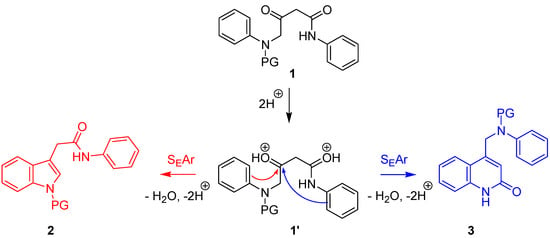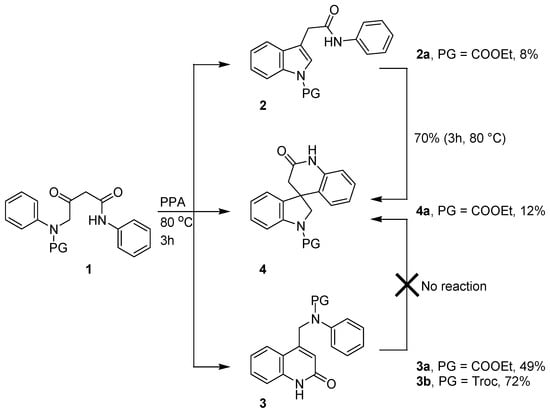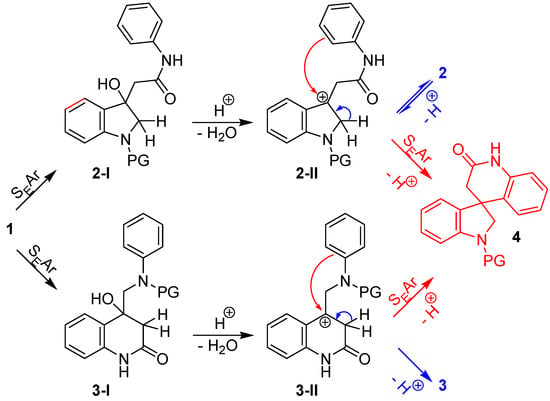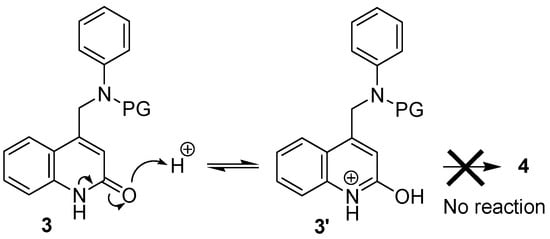Abstract
Anilides of 3-oxo-4-phenylaminobutyric acid with Troc or COOEt protection at the phenylamino group undergo competing cyclization processes in neat polyphosphoric acid at 80 °C. Depending on the protecting group and the duration of the process, three main products in different ratios are formed. Along with the quinolin-2-ones, resulting from the classic Knorr cyclization, an indole derivative and a spirocyclic product have also been obtained from the COOEt-protected substrate. It has been demonstrated that the obtained indole derivative is capable of further dearomative spirocyclization under the studied conditions.
1. Introduction
The methods for construction of quinolin-2-ones [1] and indole [2] ring systems are of utmost importance for synthetic organic chemistry, as both classes of heterocycles are vastly abundant in nature, with many examples of highly bioactive alkaloids [3,4,5]. The ring closure of oxocarbenium intermediates via intramolecular aromatic electrophilic substitution is an approach applicable to the construction of both quinolin-2-ones and indoles. In the former case, this approach is known as the Knorr synthesis [6], and it has found numerous applications in the preparation of various quinolin-2-one derivatives from β-ketoanilides [7,8]. The mechanism of this reaction has been studied in detail, and it has been shown to proceed via distonic superelectrophilic dications [9]. Indoles have also been prepared in a similar manner from appropriate α-phenylaminocarbonyl precursors [10,11], although the scope of the approach in this case is narrower and it is rarely used in comparison to other methods of indole synthesis [2].
In the course of our studies on the application of functionalized β-keto amides in the synthesis of bioactive heterocycles, we have had the opportunity to realize both modes of cyclization in precursors designed to provide either indole [11] or quinolone [12] derivatives via intramolecular aromatic electrophilic substitution. In view of these results, it was of interest to experiment with substrates that are simultaneously capable of both five- and six-membered ring formation modes (Scheme 1).

Scheme 1.
Possible modes of cyclization in anilides of N-protected 3-oxo-4-phenylaminobutyric acid.
2. Results and Discussion
To carry out the experiments, we first prepared two anilides of 3-oxo-4-phenylaminobutyric acid, bearing ethoxycarbonyl or 2,2,2-trichloroethyloxycabonyl (Troc) protection at the phenylamine nitrogen (1). For this purpose, we used our previously published protocol [13]. The substrates 1 were then subjected to Knorr-type conditions via heating in neat polyphosphoric acid (PPA) at 80 °C. The reaction was checked by TLC on 30 min intervals and the heating was maintained until full consumption of the starting compounds 1, which took 3 h in both cases. Under these conditions, the Troc-protected substrate 1b (PG = Troc) gave only one major product that could be isolated via column chromatography. Its NMR spectra corresponded to the quinolin-2-one 3b, and the yield was 72%. On the other hand, the ethoxycarbonyl protected substrate 1a (PG = COOEt) gave a mixture of three products with clear spots on the TLC plate. These products were easily separated via column chromatography on silica gel, and their spectral characteristics corresponded to the indolylacetanilide 2a (8%), the quinolin-2-one 3a (49%), and the spirocyclic derivative 4a (12%) (Scheme 2).

Scheme 2.
Products obtained from anilides of N-protected 3-oxo-4-phenylaminobutyric acid under Knorr conditions.
There are two possible mechanistic sequences leading to the formation of the spirocyclic product 4a. This product could be a result of SEAr cyclization occurring in either of two different cationic intermediates, formed after the first ring closure (Scheme 3, 2-II and 3-II). The cationic intermediates 2-II and 3-II could either eliminate a proton to give indole 2 and quinolone 3, respectively, or undergo a second SEAr process, leading to the spirocyclic product 4a. Should the proton elimination in 2-II and 3-II be reversible, then the spirocyclic product could also be obtained from any of the competing products 2 and 3. To clarify this, we carried out additional experiments, starting with pure, chromatographically isolated compounds 2a and 3a. Both compounds were heated separately in PPA, but only the indole derivative 2a underwent a dearomative spirocylization to 4a. The conversion of 2a to 4a took 3h at 80 °C and gave an isolated yield of 70%. Compound 3a on the other hand did not react even after 5h at 100 °C in either PPA or H3PO4. This suggests that the protonation of the quinolone 3 occurs preferentially at the amide oxygen, with formation of a stable aromatic 2-hydroxyquinolinium ion 3′ (Scheme 4). Although a protonation at the amide carbonyl is also likely for the indole derivative 2a, this apparently does not preclude a dearomative protonation in the five-membered ring of this compound.

Scheme 3.
Alternative pathways to the spirocyclic product 4a.

Scheme 4.
Protonation of quinolones 3.
In another experiment, the cyclization of 1a in PPA was carried out for prolonged period of 5 h, which provided enough time for product 2a to fully convert to 4a in the same reaction vessel. In this way, only products 3a and 4a were isolated in 50% and 21% yield, correspondingly.
The structures of the obtained products 2, 3, and 4 were unequivocally determined on the basis of their NMR spectra. In the 1H NMR spectrum of the spirocyclic product 4, there are signals for two AB spin systems, arising from the presence of a stereogenic center in the molecule. These signals correspond to the diastereotopic protons in the methylene groups that are adjacent to the stereogenic center. One of the methylene groups gives two doublets with 2J = 16 Hz at δA = 2.69 ppm and δB = 3.05 ppm. The protons of this AB system are bonded to a carbon with 13C δ = 42.2 ppm according to the observed HSQC correlation. This, along with the HMBC correlation of the same protons to the amide carbonyl (δ = 168.5 ppm), is sufficient to assign that methylene group to the the six-membered ring. The other methylene group appears in the 1H NMR spectrum as two doublets with 2J = 12 Hz at δA = 3.89 and δB = 4.03 ppm. These doublets correlate to a carbon with 13C δ = 60.7 ppm in the HSQC spectrum and show no correlation to the amide carbonyl in the HMBC spectrum, which assigns the corresponding methylene group to the five-membered indoline ring. Both, the five- and the six-membered-ring methylene groups, show HMBC correlation to the quaternary carbon at the spiro ring juncture, which appears at δ = 46.1 ppm in the 13C NMR spectrum. The 1H signals of the ethoxycarbonyl group in 4a are broad and unresolved, most likely due to a rotameric exchange. With regard to products 2 and 3, the most significant difference in their NMR spectra is observed in the chemical shifts of the methylene signals—δ 1H/13C = 3.79/34.7 for 2a, where the CH2 is neighbored by an indole ring and an amide carbonyl, compared to δ 1H/13C = 5.15/50.7 for 3a, where the CH2 is allylic and next to a nitrogen. In both cases, the 1H methylene signals appear as narrow doublets due to allylic coupling to a CH in the neighboring ring (4J = 1.0 and 0.9 Hz respectively). The new sp2-CH signals in 2a/3a that appear as a result of the cyclization are easily identifiable by COSY and HSQC. In the indole ring of 2a, this is the aromatic C2-H signal at δ 1H/13C = 7.68/124.4 ppm, while in the quinolone 3a, this is the C3-H at δ 1H/13C = 6.29/119.4 ppm. Here, the 1H signals are unresolved triplets because of the weak 4J coupling.
In conclusion, we have shown that the competing reaction pathways of anilides of N-protected 3-oxo-4-phenylaminobutyric acids under Knorr-conditions are influenced by the nature of the protecting group in the substrates. While the Troc-protected substrate is preferentially converted to a quinolin-2-one derivative, the COOEt-protected one gives a mixture of quinolone, indole, and spirocyclic products. Although the latter variant is of little preparative value, it revealed an interesting possibility of dearomative spirocyclization in indolylacetanilides, which may be useful in other contexts.
3. Materials and Methods
The anilides of N-protected 3-oxo-4-phenylaminobutyric acid 1 were synthesized according to our previously published protocol [13]. All other reagents and solvents were purchased from Sigma-Aldrich, Darmstadt, Germany, and were used as supplied. PPA refers to polyphosphoric acid (115% H3PO4 basis, CAS No. 8017-16-1). NMR spectra were measured on a Bruker NEO 400 (400/100 MHz 1H/13C) spectrometer. Chemical shifts (δ, ppm) are reported downfield from TMS. TLC was performed on aluminium-backed Silica gel 60 sheets (Merck, Darmstadt, Germany), with KMnO4 staining. Melting point measurements were carried out in capillary tubes on KRÜSS M5000 automatic mp meter (KRÜSS, Hamburg, Germany) and were not corrected. Mass spectral measurements were performed on a Thermo Fisher Scientific Q Exactive high-resolution mass spectrometer (Thermo Fisher Scientific, Waltham, MA, USA). IR spectra were measured on a Bruker Alpha II FT IR spectrometer (Bruker, Billerica, MA, USA).
Cyclization of compounds 1 in polyphosphoric acid, general procedure: The corresponding compound 1a,b (1 mmol) was mixed with PPA (6–8 g, 3–4 mL) in a glass vial, and the mixture was stirred intensely at 80 °C until full homogenization. The homogenous mixture was kept at 80 °C for 3 h; then, the vial was cooled to r.t. with tap water. The contents were rinsed with water (50–70 mL) and poured into a separatory funnel. The reaction products were extracted with CH2Cl2 (2 × 30 mL). The combined organic layers were dried with anhydrous Na2SO4, and the solvent was removed on a rotary evaporator. The residue was separated via column chromatography on silica gel using diethyl ether as the eluent (increasing polarity to Et2O:MeOH 20:1 for product 3a).
3-Phenylcarbamoylmethylindole-1-carboxylic acid ethyl ester (2a): m.p. 131–132 °C; 1H-NMR (400 MHz, DMSO-d6, δ ppm, J Hz): 1.40 (t, J = 7.0, 3H), 3.79 (d, J = 0.9, 2H), 4.45 (q, J = 7.0, 2H), 7.04 (m, 1H), 7.26–7.33 (m, 3H), 7.36 (m, 1H), 7.61 (m, 2H), 7.67–7.70 (m, 2H), 8.10 (d, J = 8.2, 1H), 10.21 (s, 1H); 13C-NMR (100 MHz, DMSO-d6, δ ppm): 14.64, 33.47, 63.64, 115.11, 116.02, 119.61, 120.12, 123.22, 123.73, 124.41, 125.04, 129.19, 130.63, 135.22, 139.61, 150.75, 168.86; HRMS m/z (ES+): calcd. for C19H19N2O3+ [M+H]+ 323.1390, found 323.1385.
(2-Oxo-1,2-dihydroquinolin-4-ylmethyl)-phenylcarbamic acid ethyl ester (3a): m.p. 172–173 °C; 1H-NMR (400 MHz, DMSO-d6, δ ppm, J Hz): 1.15 (t, J = 7.0, 3H), 4.14 (q, J = 7.0, 2H), 5.15 (d, J = 1.0, 2H), 6.29 (s, 1H), 7.20 (m, 2H), 7.29–7.37 (m, 5H), 7.52 (m, 1H), 7.78 (dd, J = 8.0, J = 1.1, 1H), 11.73 (s, 1H); 13C-NMR (100 MHz, DMSO-d6, δ ppm): 14.84, 50.76, 62.14, 116.16, 117.94, 119.44, 122.28, 124.31, 126.50, 126.62, 129.29, 131.01, 139.33, 141.82, 147.08, 155.22, 161.79; HRMS m/z (ES+): calcd. for C19H19N2O3+ [M+H]+ 323.1390, found 323.1392.
(2-Oxo-1,2-dihydroquinolin-4-ylmethyl)-phenylcarbamic acid 2,2,2-trichloroethyl ester (3b): m.p. 185–186 °C; 1H-NMR (400 MHz, DMSO-d6, δ ppm, J Hz): 4.97 (s, 2H), 5.23 (s, 2H), 6.36 (s, 1H), 7.19 (m, 1H), 7.25 (m, 1H), 7.32–7.39 (m, 5H), 7.52 (m, 1H), 7.79 (dd, J = 8.1, J = 1.1, 1H), 11.73 (s, 1H); 13C-NMR (100 MHz, DMSO-d6, δ ppm): 51.18, 74.92, 96.14, 116.19, 117.89, 122.27, 124.36, 126.90, 127.03, 127.35, 127.39, 129.37, 131.07, 139.34, 146.27, 153.61, 161.70; HRMS m/z (ES+): calcd. for C19H16Cl3N2O3+ [M+H]+ 425.0221, found 425.0226.
Ethyl 2′-oxo-2′,3′-dihydro-1′H-spiro[indole-3,4′-quinoline]-1(2H)-carboxylate (4a): m.p. 214–215 °C; 1H-NMR (400 MHz, DMSO-d6, δ ppm, J Hz): 1.25 (br s, 3H), 2.69 (d, 2J = 16.0, 1H), 3.05 (d, 2J = 16.0, 1H), 3.89 (d, 2J = 11.0, 1H), 4.03 (d, 2J = 11.0, 1H), 4.18 (br s, 2H), 6.61 (dd, J = 7.7, J = 1.3, 1H), 6.89 (td, J = 7.6, J = 1.3, 1H), 6.99 (dd, J = 7.9, J = 1.1, 1H), 7.06 (td, J = 7.5, J = 1.0, 1H), 7.18–7.23 (m, 2H), 7.32 (m, 1H), 7.80 (br s, 1H), 10.44 (s, 1H); 13C-NMR (100 MHz, DMSO-d6, δ ppm): 14.84, 42.26, 46.10, 60.73, 61.91, 114.84, 116.36, 123.14, 123.66, 124.48, 125.98, 128.73, 129.24, 129.47, 137.58, 152.78, 168.49; HRMS m/z (ES+): calcd. for C19H19N2O3+ [M+H]+ 323.1390, found 323.1394.
Supplementary Materials
Figures S1–S17: 1H and 13C NMR spectra of the synthesized compounds; Figures S18–S21: IR spectra of the synthesized compounds.
Author Contributions
Conceptualization, supervision, writing, P.A.; synthetic experiments, Y.M.-S. All authors have read and agreed to the published version of the manuscript.
Funding
This research was funded by the Bulgarian National Science Fund under grant number KP-06-N59/14 and by the European Union—NextGenerationEU, through the National Recovery and Resilience Plan of the Republic of Bulgaria, project DUECOS BG-RRP-2.004-0001-C01.
Data Availability Statement
The data presented in this study are available in this article and the Supplementary Materials. The raw NMR data of all compounds, including COSY, HSQC, and HMBC spectra, are available for download at https://doi.org/10.5281/zenodo.14175517 (accessed on 18 November 2024). Further inquiries can be directed to the corresponding authors.
Conflicts of Interest
The authors declare no conflicts of interest.
References
- Hong, W.P.; Shin, I.; Lim, H.N. Recent Advances in One-Pot Modular Synthesis of 2-Quinolones. Molecules 2020, 25, 5450. [Google Scholar] [CrossRef] [PubMed]
- Taber, D.F.; Tirunahari, P.K. Indole synthesis: A review and proposed classification. Tetrahedron 2011, 67, 7195–7210. [Google Scholar] [CrossRef] [PubMed]
- Khadem, S.; Marles, R.J. Natural 3,4-dihydro-2(1H)-quinolinones- Part I: Plant sources. Nat. Prod. Res. 2024, 1–16. [Google Scholar] [CrossRef]
- Khadem, S.; Marles, R.J. Natural 3,4-dihydro-2(1H)-quinolinones- Part II: Animal, bacterial, and fungal sources. Nat. Prod. Res. 2024, 1–14. [Google Scholar] [CrossRef] [PubMed]
- Heravi, M.M.; Amiri, Z.; Kafshdarzadeh, K.; Zadsirjan, V. Synthesis of indole derivatives as prevalent moieties present in selected alkaloids. RSC Adv. 2021, 11, 33540–33612. [Google Scholar] [CrossRef] [PubMed]
- Knorr, L. Synthetische Versuche mit dem Acetessigester. Justus Liebigs Ann. Chem. 1886, 236, 69–115. [Google Scholar] [CrossRef]
- Yuan, Y.; Yang, R.; Zhang-Negrerie, D.; Wang, J.; Du, Y.; Zhao, K. One-Pot Synthesis of 3-Hydroxyquinolin-2(1H)-ones from N-Phenylacetoacetamide via PhI(OCOCF3)2-Mediated α-Hydroxylation and H2SO4-Promoted Intramolecular Cyclization. J. Org. Chem. 2013, 78, 5385–5392. [Google Scholar] [CrossRef] [PubMed]
- Liu, X.; Zhang, Q.; Zhang, D.; Xin, X.; Zhang, R.; Zhou, F.; Dong, D. PPA-Mediated C–C Bond Formation: A Synthetic Route to Substituted Indeno[2,1-c]quinolin-6(7H)-ones. Org. Lett. 2013, 15, 776–779. [Google Scholar] [CrossRef] [PubMed]
- Sai, K.K.S.; Gilbert, T.M.; Klumpp, D.A. Knorr Cyclizations and Distonic Superelectrophiles. J. Org. Chem. 2007, 72, 9761–9764. [Google Scholar] [CrossRef] [PubMed]
- Julia, M.; Igolen, J. Bulletin de la Societe Chimique de France 1962, 1056–1060. Available online: https://en.wikipedia.org/wiki/Bulletin_de_la_Soci%C3%A9t%C3%A9_Chimique_de_France (accessed on 18 November 2024).
- Mollova, Y.; Angelov, P.; Yanev, P. 3-Carbamoylmethyl-Indole-1-Carboxylic Acid Ethyl Ester. Molbank 2022, 2022, M1324. [Google Scholar] [CrossRef]
- Angelov, P.; Velichkova, S.; Yanev, P. 4-Aminoalkyl Quinolin-2-one Derivatives via Knorr Cyclisation of ω-Amino-β-Keto Anilides. Molbank 2021, 2021, M1266. [Google Scholar] [CrossRef]
- Yanev, P.; Angelov, P. Synthesis of functionalised β-keto amides by aminoacylation/domino fragmentation of β-enamino amides. Beilstein J. Org. Chem. 2018, 14, 2602–2606. [Google Scholar] [CrossRef] [PubMed]
Disclaimer/Publisher’s Note: The statements, opinions and data contained in all publications are solely those of the individual author(s) and contributor(s) and not of MDPI and/or the editor(s). MDPI and/or the editor(s) disclaim responsibility for any injury to people or property resulting from any ideas, methods, instructions or products referred to in the content. |
© 2024 by the authors. Licensee MDPI, Basel, Switzerland. This article is an open access article distributed under the terms and conditions of the Creative Commons Attribution (CC BY) license (https://creativecommons.org/licenses/by/4.0/).